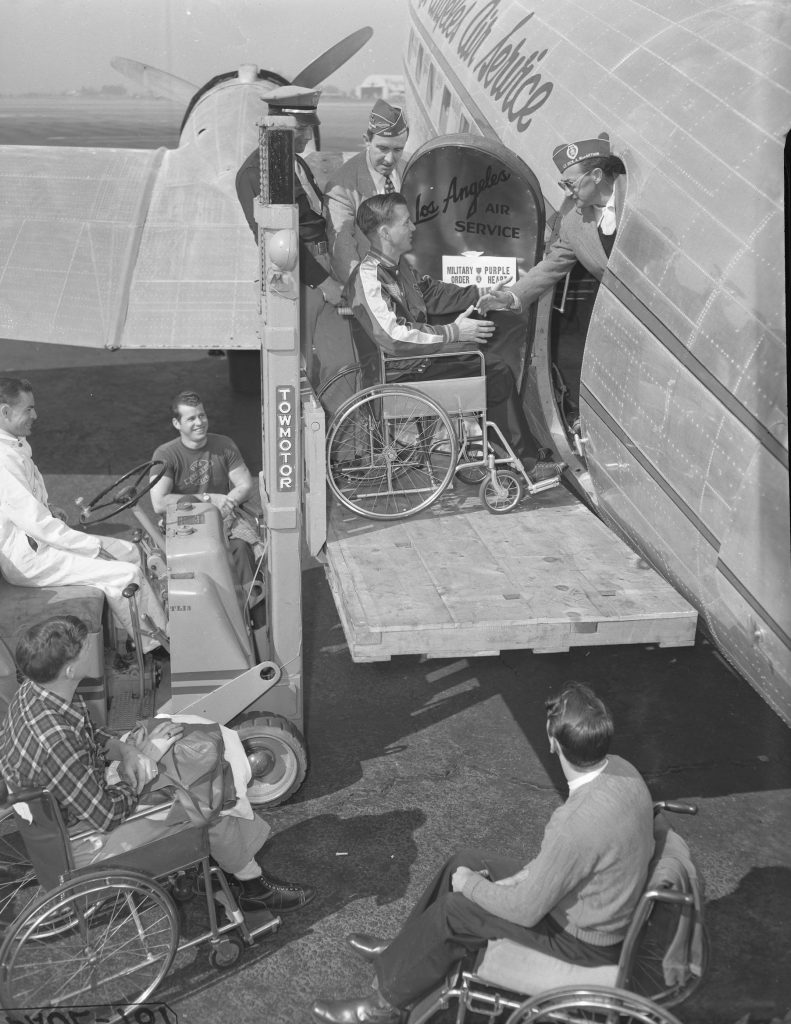On March 18, 1947, a basketball game tips off at the U.S. Naval Hospital, Corona. It has all the makings of any high stakes game. There are excited spectators and competitive players but the Birmingham Charioteers and the Norco Rolling Devils are squaring off in the first recorded game between two organized paraplegic wheelchair basketball teams.
The origins of this contest begin in part the year before at the Birmingham Veterans Administration Hospital in Van Nuys. A group of veterans, all injured and permanently confined to wheelchairs, watch a basketball game at the hospital gym. Afterwards they casually roll their chairs around the court, toss the ball around, and try a shot or two.

Assistant Athletic Director Robert Rynearson sees an opportunity. With only a few adjustments to the rules, he realizes that basketball can be used as both mental and physical rehabilitation for wheelchair patients. The vets soon begin regular practice sessions and call themselves the Charioteers.
Members of the medical staff volunteer to sit in wheelchairs to play against the Charioteers. Usually, they lose to their patients.
Navy physician Lieutenant Commander Gerald Gray attends one of the Birmingham basketball games. He notes how it’s both a fun diversion and physical therapy for paraplegics. He’s inspired to create a competitive team at the Naval Hospital in Corona.
The result is the Rolling Devils, a basketball team comprised of young veterans who have suffered paralysis during the war through accident, combat injury, and polio.
It’s an unprecedented time in medical history for those with a paraplegic condition. Most who suffer the same types of injuries in World War I likely died from trauma or infection. By the 1940s, penicillin and improved surgical techniques save lives, but updated ideas for ongoing and long-term treatment are still in their infancy.
Up until this time, lying in bed for up to a year and staying confined to the hospital are usual recommendations. For most people with spinal cord injuries, the prognosis and prospects of their future lives are grim.

World War II brings a change, when medical facilities and spinal injury specialists around the world begin to realize that treating the whole person – mind, body, and soul – is the best prescription for recovery and rehabilitation.
At veteran and military hospitals this means focusing on the patient’s abilities, getting the growing number of war injured out of bed, and providing emotional and mental stimulation along with physical exercise. Sports and competition are one type of medicine, and basketball is easily adaptable for wheelchair play.
The success of the Charioteers and the Rolling Devils continues beyond 1947. Both teams travel throughout California and the country playing exhibition games for sold out crowds. They play against able-bodied amateur and semi-professional basketball players and almost always win by a good margin. The Charioteers complete a barnstorming tour which includes stops in Amarillo, Chicago, Buffalo, Richmond, Washington D.C., Cincinnati, and Memphis.
The rising popularity of wheelchair basketball permanently alters the public’s awareness and perception of paraplegics and disability rights.

The National Wheelchair Basketball Association (NWBA) organizes in 1948 and currently governs more than 200 wheelchair basketball teams across 22 conferences for both men and women. The City of Norco continues to regularly host a NWBA-sanctioned tournament to commemorate the historic first game.
The final score of that memorable game? Birmingham Charioteers over the Norco Rolling Devils, 20-6.
